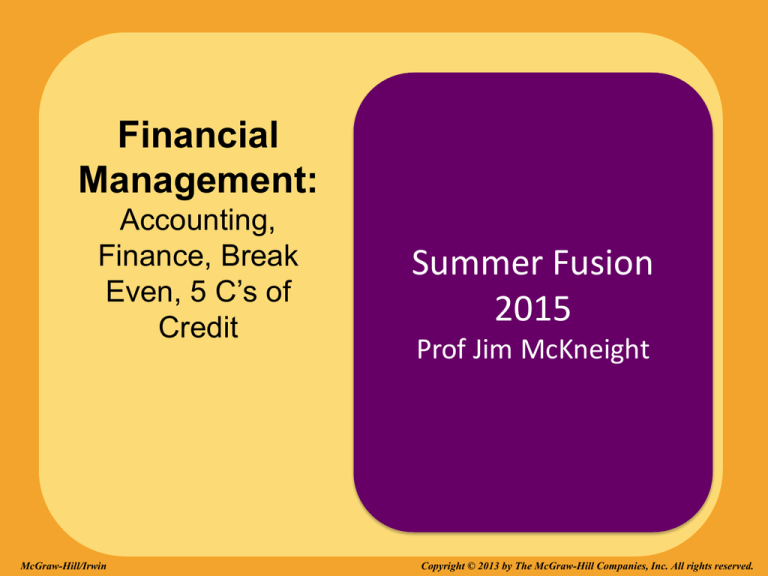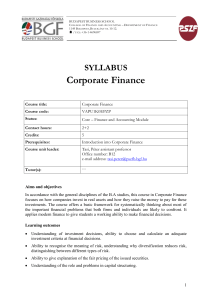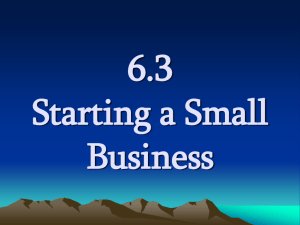
Financial
Management:
Accounting,
Finance, Break
Even, 5 C’s of
Credit
McGraw-Hill/Irwin
Summer Fusion
2015
Prof Jim McKneight
Copyright © 2013 by The McGraw-Hill Companies, Inc. All rights reserved.
Opening Questions
1. Are Finance & Accounting the same thing?
2. If not, what’s the difference?
The Role of Accounting
• Accounting reports and financial statements reveal as
much about a business’s health as pulse and blood
pressure readings tell us about a person’s health.
• Thus, you have to know something about accounting if
you want to succeed in business.
• It is almost impossible to understand business operations
without being able to read and analyze accounting
reports and financial statements.
3
The Accounting System
The Accounting Cycle
Accounting Cycle -- A six-step procedure that results in
the preparation and analysis of the major financial
statements.
Statement of Cash Flows: Definition and
Use
• Statement of Cash Flows:
shows how cash, reflected in accrual accounting, flowed into and
out of a firm during a specific period of operation
• Can be used to determine if a venture has
been building or burning cash
• “Net Cash Burn” occurs when the sum of
cash flows from “operations” and
“investing” is negative
6
7
Financial Statement Analysis
Outside users are interested in these questions:
1. Is the organization profitable?
2. Is it able to pay its bills?
3. How much debt does it owe?
To answer these questions, financial ratios are often
used.
COMMONLY USED RATIOS
• Liquidity ratios measure a firm’s ability to turn assets
into cash to pay its short-term debts.
• Key ratio: Current Ratio (Current Assets / Current
Liabilities)
• This information is found on the firm’s balance sheet.
17-9
COMMONLY USED RATIOS
• Leverage ratios measure the degree to which a firm
relies on borrowed funds in its operations.
• Key ratio: Debt to Owner’s Equity Ratio (Total Debt /
Total Owners Equity)
• This information is found on the firm’s balance sheet.
17-10
Financial Break Even
• One of the most important financial concepts is the concept
of financial break even.
• Why? Because you do not make a single dollar of profit until
you first break even.
• Most businesses fail to reach their profit potential because
the owners have not performed B/E analysis.
• Managing your fixed costs and using B/E analysis to make
spending decisions will save you thousands of dollars!
• This break even concept works for personal finances too, it is
essentially an easy way to budget.
Breakeven Analysis: Basic Terms
• Variable Expenses:
costs or expenses that vary directly with revenues
• Fixed Expenses:
costs that are expected to remain constant over a range of revenues
for a specific time period
• Basic Equations:
1. Breakeven Point (units) = Fixed Costs / Contribution Margin Per
Unit
2. Breakeven Point (revenue) = BE Point (units) x Price per unit
(Handout Problems)
12
The Role of
Finance and
Financial
Managers
WHAT’S FINANCE?
LG1
• Finance -- The function in a business that acquires
funds for a firm and manages them within the firm.
• Finance activities include:
- Preparing budgets
- Creating cash flow analyses
- Planning for expenditures
18-13
The Role of
Finance and
Financial
Managers
FINANCIAL MANAGEMENT
LG1
• Financial Management -The job of managing a firm’s
resources to meet its goals
and objectives.
18-14
The Role of
Finance and
Financial
Managers
FINANCIAL MANAGERS
LG1
• Financial Managers -- Examine financial data and
recommend strategies for improving financial
performance.
• Financial managers are
responsible for:
- Paying company bills
- Collecting payments
- Staying abreast of market
changes
- Assuring accounting
accuracy
18-15
The Role of
Finance and
Financial
Managers
LG1
WHAT FINANCIAL
MANAGERS DO
18-16
The Value of
Understanding
Finance
LG1
WHY DO FIRMS
FAIL FINANCIALLY?
1) Undercapitalization
2) Poor control over
cash flow
3) Inadequate expense
control
18-17
The Value of
Understanding
Finance
LG1
TOP FINANCIAL CONCERNS
of COMPANY CFOs - MICRO
• Ability to maintain margins
• Ability to forecast results
• Maintaining
morale/productivity
• Cost of healthcare
• Working-capital
management
Source: CFO Magazine, July/August 2010.
18-18
Financial
Planning
FINANCIAL PLANNING
LG2
• Financial planning involves analyzing short-term
and long-term money flows to and from the
company.
• Three key steps of financial planning:
1. Forecasting the firm’s short-term and long-term
financial needs.
2. Developing budgets to meet those needs.
3. Establishing financial controls to see if the company is
achieving its goals.
18-19
Forecasting
Financial
Needs
FINANCIAL FORECASTING
LG2
• Short-Term Forecast -- Predicts revenues, costs
and expenses for a period of one year or less.
• Cash-Flow Forecast -- Predicts the cash inflows
and outflows in future periods, usually months or
quarters.
• Long-Term Forecast -- Predicts revenues, costs,
and expenses for a period longer than one year and
sometimes as long as five or ten years.
18-20
Working with
the Budget
Process
BUDGETING
LG2
• Budget -- Sets forth management’s expectations
for revenues and allocates the use of specific
resources throughout the firm.
• Budgets depend heavily on the balance sheet,
income statement, statement of cash flows and
short-term and long-term financial forecasts.
• The budget is the guide for financial operations
and expected financial needs.
18-21
Working with
the Budget
Process
FINANCIAL PLANNING
LG2
18-22
The Need for
Operating
Funds
LG3
KEY NEEDS for OPERATIONAL
FUNDS in a FIRM
• Managing day-by-day
needs of the business
• Controlling credit
operations
• Acquiring needed
inventory
• Making capital
expenditures
18-23
The Need for
Operating
Funds
LG3
HOW SMALL BUSINESSES
CAN IMPROVE CASH FLOW
• Be more aggressive in
collecting accounts receivable.
• Offer customers discounts for
paying early.
• Take advantage of special
payment terms from vendors.
• Raise prices.
• Use credit cards discriminately.
Source: American Express Small Business Monitor.
18-24
Alternative
Sources of
Funds
LG3
USING ALTERNATIVE
SOURCES of FUNDS
• Debt Financing -- The
funds raised through various
forms of borrowing that must
be repaid.
• Equity Financing -- The
funds raised from within the
firm from operations or
through the sale of ownership
in the firm (such as stock).
18-25
Alternative
Sources of
Funds
LG3
SHORT and LONG-TERM
FINANCING
• Short-Term Financing -Funds needed for a year or
less.
• Long-Term Financing -Funds needed for more than
a year.
18-26
Alternative
Sources of
Funds
WHY FIRMS NEED FINANCING
LG3
Short-Term Funds
Long-Term Funds
Monthly expenses
New-product development
Unanticipated emergencies
Replacement of capital equipment
Cash flow problems
Mergers or acquisitions
Expansion of current inventory
Expansion into new markets
Temporary promotional programs
New facilities
18-27
Trade Credit
LG4
TYPES of
SHORT-TERM FINANCING
• Trade Credit -- The practice of buying goods or
services now and paying for them later.
• Businesses often get terms 2/10 net 30 when
receiving trade credit.
• Promissory Note -- A written contract agreeing to
pay a supplier a specific sum of money at a definite
time.
18-28
Commercial
Banks
LG4
DIFFICULTY of OBTAINING
SHORT-TERM FINANCING
• Banks generally
prefer to lend shortterm money to larger,
more established
businesses.
• The recent financial crisis has made it difficult for
even promising and well-organized businesses to
get loans.
18-29
Different
Forms of
Short-Term
Loans
LG4
DIFFERENT FORMS of
SHORT-TERM LOANS
• Commercial banks offer short-term loans like:
- Secured Loans -- Backed by collateral.
- Unsecured Loans -- Don’t require collateral
from the borrower.
- Line of Credit -- A given amount of money the
bank will provide so long as the funds are
available.
- Revolving Credit Agreement -- A line of
credit that’s guaranteed but comes with a fee.
18-30
Credit Cards
CREDIT CARDS
LG4
• Rates for small businesses
grew almost 30% after the
Credit Card Responsibility
Accountability and
Disclosure Act was passed.
• Credit cards are convenient
but costly for a small
business.
Photo Courtesy of: Robert Scoble
18-31
Credit Cards
LG4
WAYS to RAISE
START-UP CAPITAL
• Seek out a microloan from a microlender
• Use asset-based lending or factoring
• Turn to the web and seek
out peer-to-peer lending
• Research local banks
• Sweet-talk vendors you
want to do business with
Source: Entrepreneur, www.entrepreneur.com, accessed July 2011.
18-32
Debt
Financing
LG5
USING LONG-TERM
DEBT FINANCING
• Long-term financing loans generally come due
within 3 -7 years but may extend to 15 or 20
years.
• Term-Loan Agreement -- A promissory note that
requires the borrower to repay the loan with interest
in specified monthly or annual installments.
• A major advantage of debt financing is the
interest the firm pays is tax deductible.
18-33
Equity
Financing
SECURING EQUITY FINANCING
LG5
• A company can secure equity financing by:
- Selling shares of stock in the
company.
- Earning profits and using the
retained earnings as
reinvestments in the firm.
- Attracting Venture Capital -Money that is invested in new
or emerging companies that
some investors believe have
great profit potential.
18-34
Obtaining
Long-Term
Financing
The FIVE “C”s of CREDIT
LG5
1. The character of the borrower.
2. The borrower’s capacity to repay the loan.
3. The capital being invested in the business by
the borrower.
4. The conditions of the economy and the firm’s
industry.
5. The collateral the borrower has available to
secure the loan.
18-35






